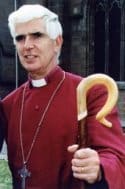
By Matin Durrani
Quantum physics is notoriously counter-intuitive and difficult to grasp, which is perhaps why the subject is often invoked to explain other seemingly counter-intuitive and difficult-to-grasp areas of life.
But that doesn’t mean that wheeling out the subject necessarily makes any sense.
So here’s to the former Bishop of Southwark, Thomas Frederick ‘Tom’ Butler, whose comments on the Thought for the Day slot on BBC Radio 4 this morning (at about 1.47) are a classic of the genre.
The bishop begins, for some reason, by talking about the search for the Higgs boson (or Higgs “bos’un” as he irritatingly puts it) at CERN’s Large Hadron Collider, which, he reveals to the world, “will shortly be reactivated”. (I presume he means restarted after the scheduled winter shut-down as the scientists on the machine have happily been taking data for more than two years now.)
Having brought up the LHC, Butler then jumps suddenly into quantum physics, bemoaning his lack of understanding of the subject. But that’s okay, we’re told, because Niels Bohr once said that “those who aren’t shocked when they first come across quantum theory can’t possibly have understood it”. (Quote a heavyweight from science – that’ll impress the listeners.)
And so to the heart of the matter: fundamental entities can be both particles and waves, which is, er, a bit like religion really. “Paradoxically it [quantum mechanics] has made some of the traditional problems of the nature of God easier to understand,” says the bishop, pointing out, for example, that Jesus is both human and divine.
Butler admits he found it hard, when he was younger, to come to terms with this paradox. “I found this both/and faith world difficult to grasp,” he says. “Surely this paradox couldn’t be right?”
Ah, but all’s well now, thanks to quantum physics. “It tells us the world is paradox. The fundamental nature of existence is both/and.”
But if you have any lingering doubts over the validity of quantum physics, don’t worry. “Hopefully we’ll soon have the Higgs boson to give the theory the stamp of approval.”
You can relive the whole item here – jump to about 1.47 minutes.


